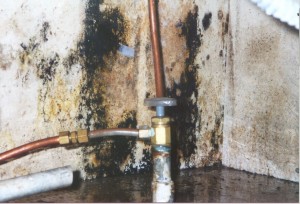How do I find out if I have a problem?
If you suspect you have a mold problem, you can investigate yourself. If you can’t find anything, it may be time to call in a professional with the tools to detect hidden problems without destroying your home.
How do I tell if I have a mold problem?
If you notice things like a musty smell or find a water leak, there is a chance you may have a mold problem. Going out and buying a test kit isn’t the way to go! Investigate with your eyes…use your senses they are much better at detecting a mold problem. Tests detect mold. If you read earlier you know mold is a naturally occurring thing…it’s in your house all the time whether you have a problem or not. A test kit will only prove this statement.
If there is an earthy or musty smell or you see mold actually growing somewhere, then you should assume there is a mold problem. Other clues are worsening of allergy-like symptoms or signs of excess moisture in your home.
- Look for visible mold growth. Mold often appears as discoloration on building materials but may also appear fuzzy, cottony, velvety, granular or leathery. It can be white, gray, brown, black, yellow and even green.
- Search in areas with noticeable mold odors.
- Look for signs of excess water or damage. Watch for discoloration indicating any type of water leaks, puddles, stains and condensation.
- Search behind/underneath items. Look under vinyl flooring, under the carpet and pad and inside sink cabinets. Sometimes destructive searches are needed, such as opening up a wall cavity.
Should I test for mold?
Generally, if you can see or smell mold, there is a problem and testing has little value. In this case, it is wasteful to test for mold when you know it’s there. This can take away needed resources for the remediation of the mold problem. In this case, testing is of little value with regard to health problems, also. It is there. You need to eliminate it, not test it!
Sometimes, mold is hidden. In this case, the taking of air samples both inside and outside the home as well as material samples may help determine the extent of contamination. But since mold is naturally occurring, these tests should be conducted by a professional who can correctly interpret the results.

